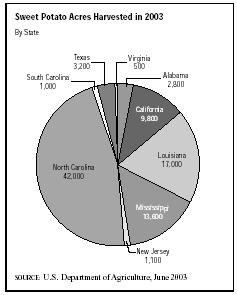SIC 0139
FIELD CROPS EXCEPT CASH GRAINS, NOT ELSEWHERE CLASSIFIED
This entry includes establishments primarily engaged in the production of field crops, except cash grains, not classified elsewhere. This category includes a range of crops for human or livestock consumption, encompassing farms that produce alfalfa, broomcorn, clover, grass seed, hay, hops, mint, peanuts, sweet potatoes, timothy, and yams. This category also includes establishments deriving 50 percent or more of their total value of sales of agricultural products from field crops, except cash grains, but less than 50 percent from products of any single industry.

NAICS Code(s)
111940 (Hay Farming)
111992 (Peanut Farming)
111219 (Other Vegetable (except Potato) and Melon Farming)
111998 (All Other Miscellaneous Crop Farming)
Sweet Potatoes and Yams. Yams grown in the United States are actually a variety of sweet potato, but with a moister, golden red flesh. Sweet potatoes are light yellow or pale orange in color. Yams, grown primarily in North Carolina, account for about half of all sweet potato consumption in the United States, and are consumed mainly in the northeast and mid-Atlantic states. North Carolina is the leading producer of sweet potatoes, with Louisiana, Mississippi, and California following as major producers. With increasing production and sales of sweet potatoes, 2003 brought the total number of acres harvested to 91,000, compared to 83,500 acres harvested in 2002, despite a drop in acres planted from 97,200 to 94,000 over the same time period.
Hay. Grass, alfalfa, clover, and timothy are all used for livestock fodder. Farmers grow hay for their own livestock or for commercial sale. Some dairy farmers buy grain and use their fields for quality forage crops since well-managed alfalfa, for example, can provide more net income per acre than grain crops such as corn or soybeans, according to farmers and researchers in the trade journal Implement & Tractor. In 2003, harvested hay continued the trend of decreased production with 64.3 million acres harvested, compared to 64.5 million acres harvested in 2002. Leading hay producers in 2003 included Texas, Missouri, North and South Dakota, and Kansas. South Dakota was the leading alfalfa producer.
According to Implement & Tractor, Wisconsin researchers have found that the nutritional value of alfalfa and other hays depends on when it is cut and have noted that milk production of dairy cattle rose dramatically when cows were fed alfalfa that was harvested at first flower. In some areas, hay marketing cooperatives hold regular hay auctions with hay-testing services, since demand is up for high quality hay for dairy cattle.
Peanuts. Peanuts have ranked as the eighth leading field crop with an annual value of about $1.2 billion, and the United States is one of the third largest producers of peanuts in the world. The United States harvested about 1.22 million acres of peanuts in 2003. Georgia is the leading producer, averaging about 50 percent of the country's total peanut crop per year. Other leading producers include Texas, Alabama, Florida, North Carolina, Oklahoma, and Virginia.
The peanut industry has been regulated by government price support and quota programs since the 1930s. Though support prices guarantee peanut farmers a minimum price for their crops, the Federal Agriculture Improvement and Reform Act of 1996, or Farm Bill, reduced and froze the loan rate at 10 percent. The government also imposes production quotas on regions and even on individual farms within the regions, according to the unit's historical share of production; the nation's total production quota is based on expected food and seed use for the coming year. However, the 1996 Farm Bill called for the elimination of the floor quota, because, in recent years, production had fallen below the 1.35 million tons stipulated in the 1990 bill. The legislation allows for the annual determination of the year's quota to avoid the previous situation of being manacled to a quota from years before. The government has set up a two-tiered pricing system which distinguishes between "quota peanuts" and "additional peanuts." Quota peanuts are used for domestic food products or for seed and receive higher price supports than additional peanuts. Additional peanuts can be sold only for export or for processing into peanut oil or peanut meal. Farmers may produce both quota and additional peanuts. The 2002 Farm Bill, signed by President Bush in May of that year, amended the Farm Bill by extending price supports to peanut farmers for the next six years.
Mint. Oregon is the leading producer of peppermint, followed by Washington and Idaho. Production costs can be high for growers. Spearmint is primarily grown in Washington, Wisconsin, and Indiana. Mint varieties, as herbs and oils, have a host of applications, including being a spice, a cosmetic agent, an ingredient in tea, and a flavoring for toothpaste. Although the total number of peppermint acres harvested in the United States declined by nearly 1,000 in 2002 to reach 5,200 acres, yield per acre grew from 50 pounds to 60 pounds over the course of that year. Spearmint harvested in 2002 also fell by 1,000 acres, settling at 2,200 acres, as yield declined 24 percent.
Further Reading
Ayer, Harry. "The U.S. Farm Bill: Help or Harm for CAP and WTO Reform." Agra Europe, 24 May 2002.
Food and Agriculture Policy Research Institute. "Implications of the 2002 U.S. Farm Act for World Agriculture." 24 April 2003. Available from http://www.fapri.missouri.edu .
U.S. Department of Agriculture. "Vegetables and Melons" Washington, DC, 2003. Available from http://usda.mannlib.cornell.edu/reports/nassr/field/pcp-bba/acrg0603.txt .
Comment about this article, ask questions, or add new information about this topic: